
Ballyclare is a small town in County Antrim, Northern Ireland. It had a population of 10,850 according to the 2021 census, and is located within the Antrim and Newtownabbey Borough Council area. It is part of, and the principal settlement in the Ballyclare District Electoral Area.
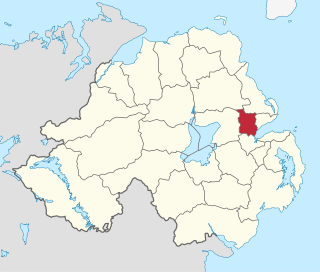
Newtownabbey Borough Council was a Local Authority in County Antrim in Northern Ireland, on the north shore of Belfast Lough just immediately north of Belfast. The Council merged with Antrim Borough Council in April 2015 under local government reform in Northern Ireland to form Antrim and Newtownabbey Borough Council.

Bangor Castle is a country house situated in Castle Park in Bangor, County Down, Northern Ireland. The building, which is also referred to as Bangor City Hall and is now used as the offices of Ards and North Down Borough Council, is a Grade A listed building.
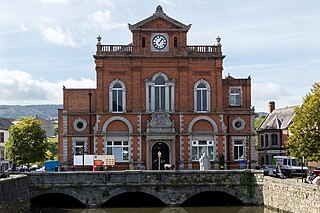
Newry Town Hall is a municipal structure in Bank Parade in Newry, Northern Ireland. It was built on a specially-constructed bridge across the Newry River, which forms part of the historic border between County Armagh and County Down. The town hall, which was the headquarters of Newry Urban District Council, is a Grade B1 listed building.
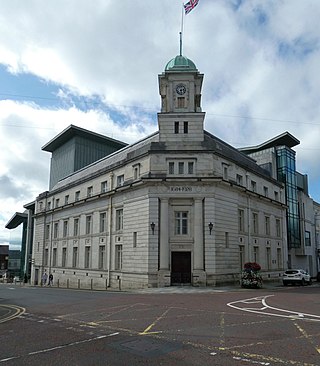
Ballymena Town Hall is a municipal structure in Bridge Street in Ballymena, County Antrim, Northern Ireland. The town hall, which is the headquarters of Mid and East Antrim Borough Council, is a Grade B1 listed building.

Carrickfergus Town Hall is a municipal structure in Joymount in Carrickfergus, County Antrim, Northern Ireland. The town hall, which was the headquarters of Carrickfergus Borough Council, is a Grade B+ listed building.
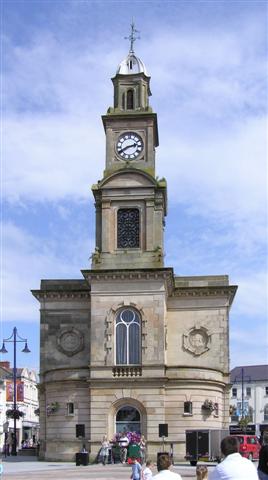
Coleraine Town Hall is a municipal structure in The Diamond in Coleraine, County Londonderry, Northern Ireland. The town hall, which was the headquarters of Coleraine Borough Council, is a Grade B1 listed building.
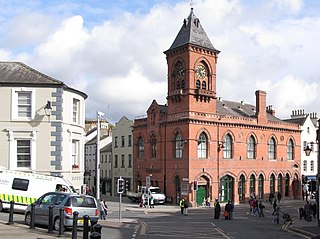
The Down Arts Centre, formerly Downpatrick Town Hall and also Downpatrick Assembly Rooms, is a municipal structure in Irish Street in Downpatrick, County Down, Northern Ireland. The structure, which was the meeting place of Down Urban District Council, is a Grade B1 listed building.
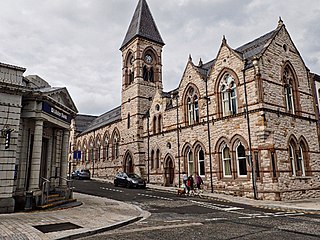
Larne Town Hall is a municipal structure in Upper Cross Street in Larne, County Antrim, Northern Ireland. The structure, which was the meeting place of Larne Borough Council, is a Grade B+ listed building.

The Old Town Hall is a municipal structure in Scarva Street in Banbridge, County Down, Northern Ireland. The structure, which currently accommodates a Community Advice Centre on the ground floor and a room for local community groups on the first floor, is a Grade B1 listed building.

Rothesay Town Hall and County Buildings is a former municipal building in Castle Street, Rothesay, Scotland. The structure, which was the meeting place of Rothesay Burgh Council and of Bute County Council, is a Category B listed building.

The Roe Valley Arts & Cultural Centre, formerly the Alexander Memorial Hall and originally Limavady Town Hall, is a civic venue in Main Street in Limavady, County Londonderry, Northern Ireland. The structure, which incorporates the façade of the old town hall, was previously a Grade B1 listed building but was delisted in July 1998 to facilitate the demolition of the structure behind the façade and the subsequent erection of a new cultural centre.
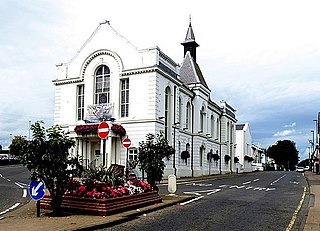
Ballymoney Town Hall is a municipal structure in the High Street, Ballymoney, County Antrim, Northern Ireland. The structure, which incorporates a local history museum, is a Grade B1 listed building.
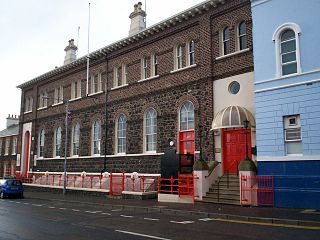
Lurgan Town Hall is a municipal structure in Union Street, Lurgan, County Armagh, Northern Ireland. The structure, which is primarily used as a community, arts and resource centre, is a Grade B1 listed building.

Portadown Town Hall is a municipal structure in Edward Street, Portadown, County Armagh, Northern Ireland. The structure, which is primarily used as a theatre, is a Grade B1 listed building.
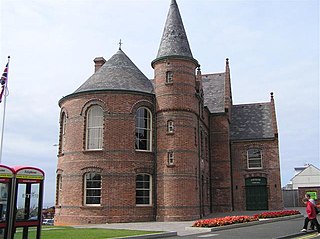
Portrush Town Hall is a municipal structure in Mark Street, Portrush, County Antrim, Northern Ireland. The structure, which is used as an events venue, is a Grade B+ listed building.
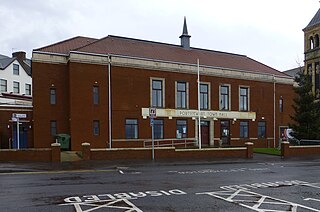
Portstewart Town Hall is a municipal structure in The Crescent, Portstewart, County Londonderry, Northern Ireland. The structure, which has been closed to the public since December 2019, is a Grade B2 listed building.

Donaghadee Town Hall, also known as The Merchant House, is a municipal structure in the High Street, Donaghadee, County Down, Northern Ireland. The structure, which has been converted for residential use, is a Grade B+ listed building.

Campbeltown Town Hall is a municipal structure in Main Street in Campbeltown, Argyll and Bute, Scotland. The structure, which is used as a community events venue, is a Category B listed building.

Kinross Town Hall forms part of a complex of municipal buildings in the High Street, Kinross, Perth and Kinross, Scotland. The town hall, which has been converted for residential use, is a Category B listed building.






















